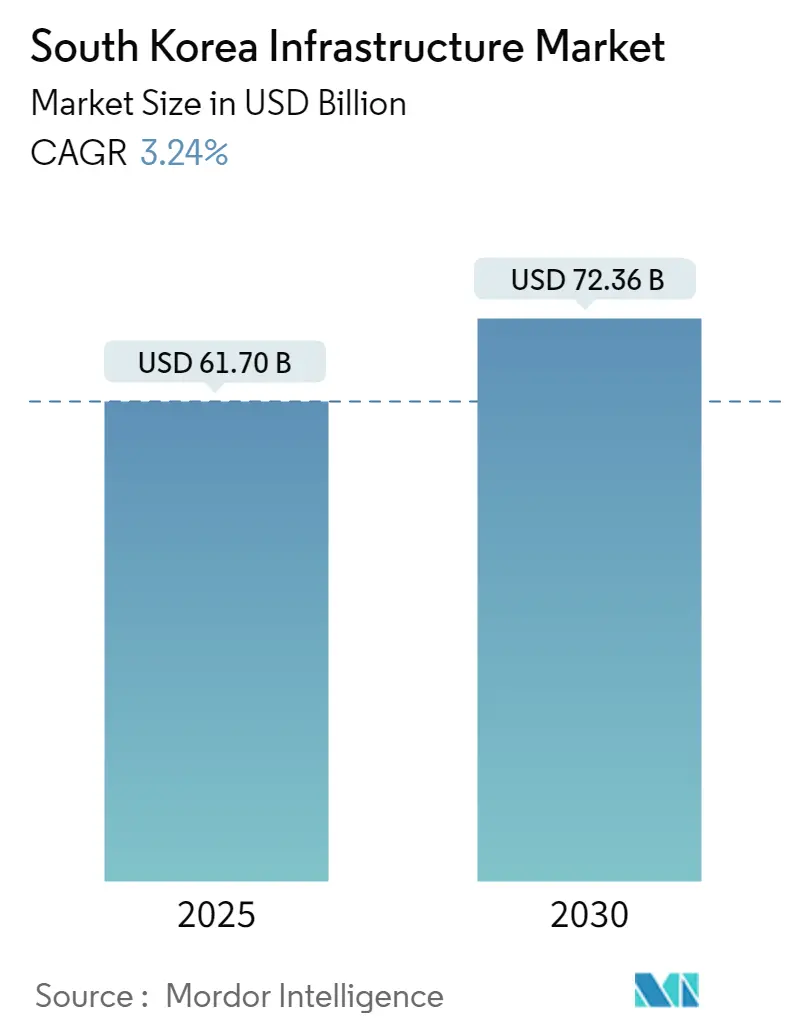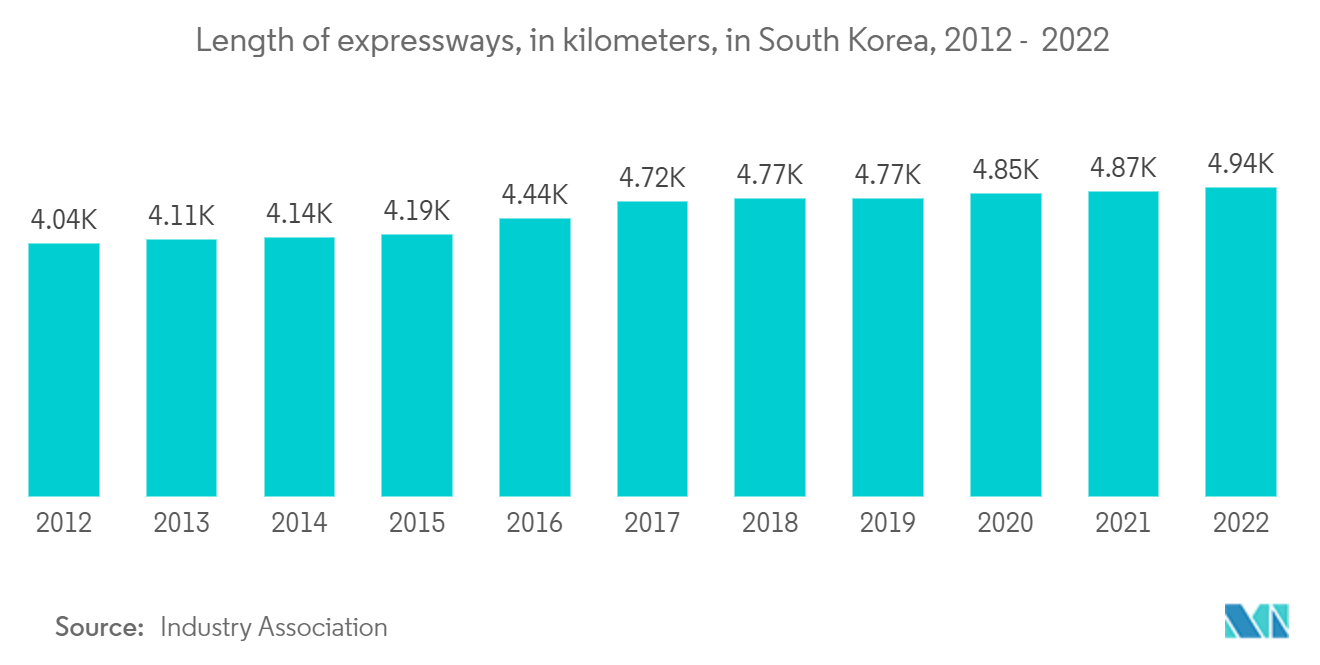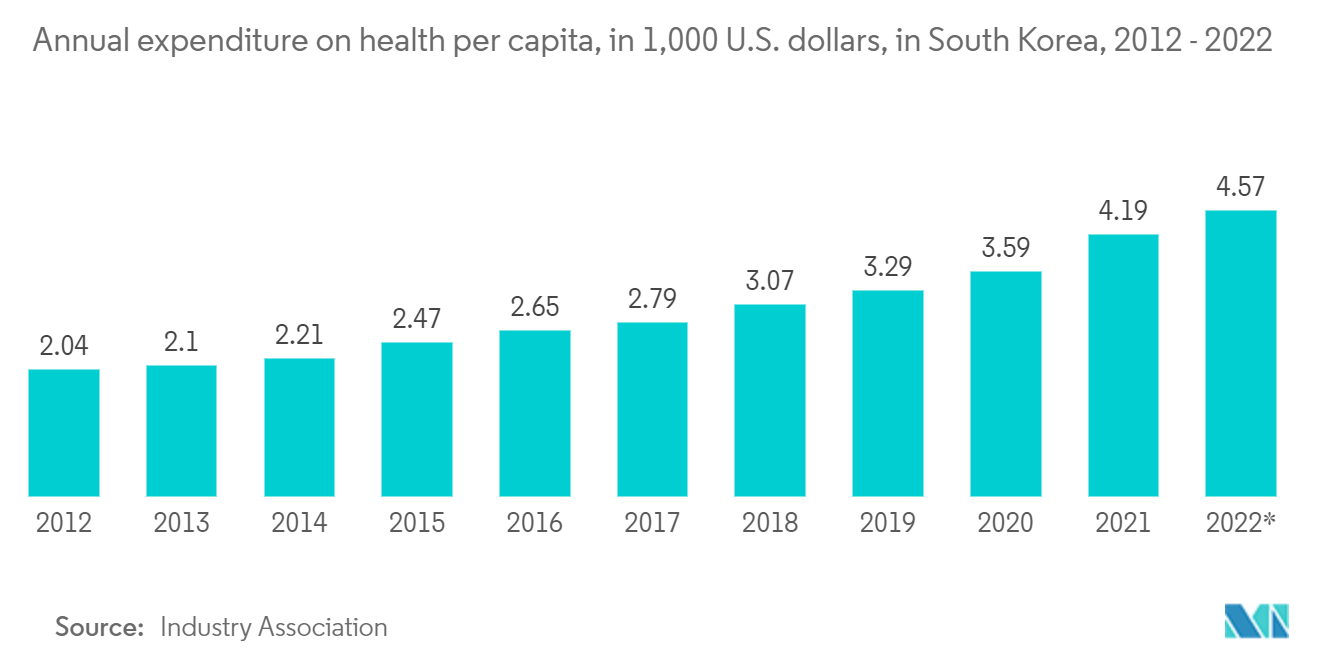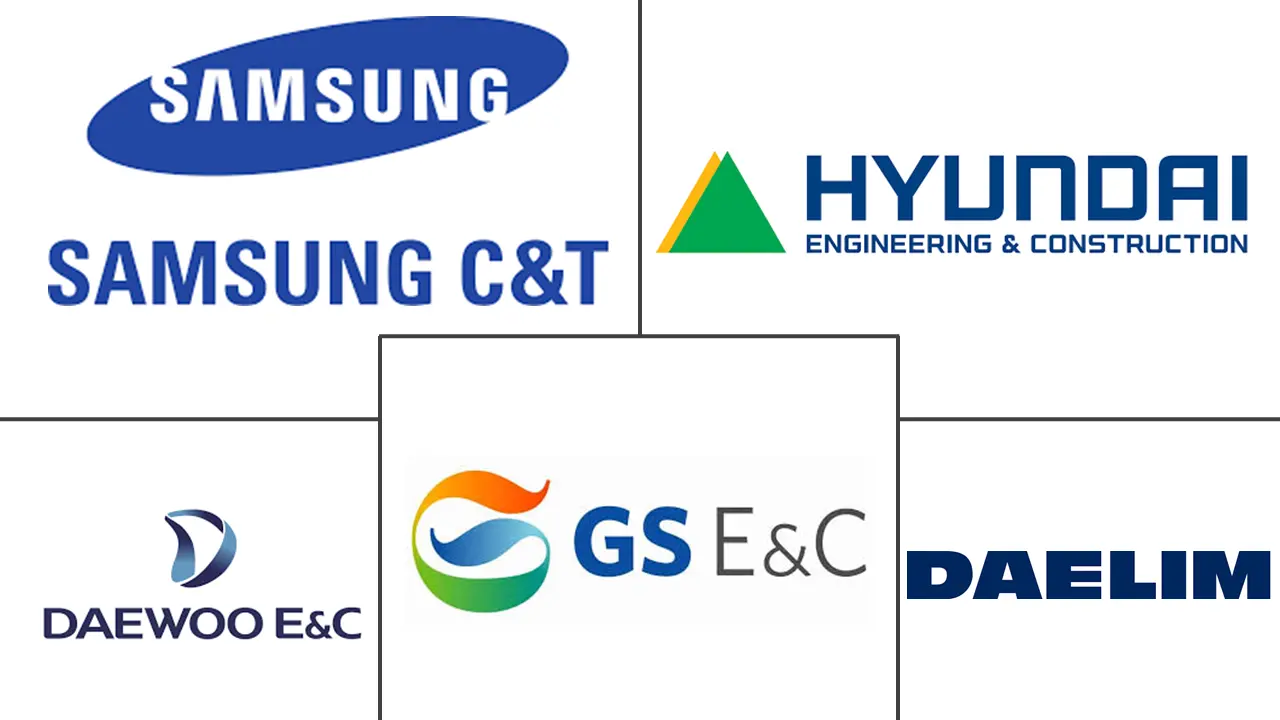
South Korea Infrastructure Market Analysis
The South Korea Infrastructure Market size is estimated at USD 61.70 billion in 2025, and is expected to reach USD 72.36 billion by 2030, at a CAGR of 3.24% during the forecast period (2025-2030).
- South Korea is an ideal market for US firms seeking to test cybersecurity solutions before deploying them in other markets due to its leadership in high-speed internet use and advanced ICT infrastructure.
- While companies that create sophisticated and cutting-edge products for critical infrastructure are more likely to succeed, there are also opportunities for companies that provide cybersecurity consulting and training services. Overall, the Korean market prefers the quality and dependability of American products, and demand for American goods is expected to remain strong. South Korea is developing its AI capabilities and wants to become a global player in the AI technology markets. ROK officials see AI as critical to the country's ICT prowess and are committed to making Korea an AI powerhouse.
- One of the key factors driving the growth of the VDI market in South Korea is the growing need for remote support across various organizations. Remote support software is in high demand due to increasing internet speeds and the need for cost-effective solutions to optimize various business operations. Also, remote support software solutions benefit businesses that focus on resolving end-user technical issues.
- Many consumers use solutions for battery optimization, firmware support, and malware detection. Many small businesses are equipping their IT help desks with remote support software to provide technical support to such customers. The growing demand for remote support solutions will drive market growth during the forecast period.
- Because of information and communication technology advances, the mobility sector is undergoing a major transformation. The South Korean government's Ministry of Land, Infrastructure, and Transport has unveiled the "Mobility Innovation Roadmap" to establish its leadership in the mobility sector and promote innovative services.
- The ministry formed the 'Mobility Innovation Committee,' which is made up of private-sector experts working solely in the fields of transportation, consumer, and information technology. The ministry intends to expand and reorganize the Mobility Innovation Committee into a public-private joint organization to ensure the mobility roadmap's smooth implementation, review the roadmap's implementation status, and discuss the discovery of new tasks and the supplementation of existing ones.
- South Korea's exports reached USD 644.5 billion in 2021, the highest ever, owing to strong sales of major industries and the growth of new industries. Despite the COVID-19 pandemic, Korean firms were able to minimize production disruptions, and major industries such as semiconductors, shipbuilding, and automobiles led the global market in terms of product competitiveness. Cosmetics, agriculture, marine products, and plastics were among the new export industries that grew significantly.
- In 2023, the top 15 major export items, which included semiconductors, petrochemicals, and automobiles, increased by double digits. It is the first time that all 15 items have increased simultaneously. This has been made possible by the country's infrastructure growth, which the country's manufacturing growth has supplemented.
South Korea Infrastructure Market Trends
Investment on Transportation Infrastructure Driving the Market
To facilitate the early operation of the high-tech future mobility network, the country intends to overhaul the public transportation system by 2024. South Korea hopes that by 2035, half of all new cars will be fully automated and that traffic-related deaths will be reduced to under 1000 per year. Another important goal was for South Korea to release a Level 3 autonomous car by the end of 2022, making it the third country in the world after Germany and Japan. Autonomous buses will be available on public roads by 2025, and cars will be available by 2027. To accommodate Level 4 automation, the country will also change car insurance, driver's licenses, and traffic laws. Real-time communication infrastructure will be built on national roads by 2030.
Transport is an essential component of the economy. It makes daily commutes more convenient, allows one to travel freely to all corners of the country, and allows one to receive parcels and other goods in the comfort of one's home. The transportation and logistics industries are indeed the pillars that support Korea's economy, and new modes of mobility, such as autonomous vehicles and urban air mobility (UAM), are providing new impetus for future growth. The Ministry of Land, Infrastructure, and Transport will work to innovate the entire transportation industry to bring practical improvements to the public's daily lives.
MOLIT will accelerate key transportation projects such as the Great Train eXpress (GTX), metropolitan/high-speed railways, underground expressways, and the new airport in Gadeokdo to address traffic congestion in metropolises and achieve more balanced national growth. To provide consumer-centric services, public transportation will make an innovative shift. MOLIT intends to increase investment in expanding public transportation services and improving intermodal transfer while updating outdated regulations. Efforts will also be made to improve transportation accessibility for vulnerable groups such as people with disabilities, older people, and those living in remote areas. The transportation industry is currently undergoing a period of rapid mobility transformation.

Increased Support of Health Infrastructure Driving the Market
Samsung Medical Center in South Korea has been working to become an advanced intelligent hospital, the world's first hospital to achieve the highest stage in the HIMSS Infrastructure Adoption Model. An innovative hospital of the future will need three things: mass data communication, multi-species, and mass device connectivity, as well as seamless service convergence. Smart parking, medical, incremental location checks, automated medical payment, smart call center system, automated medical equipment interface, and logistics innovations through robots are among the key projects it sought to implement through this roadmap.
South Korea needs medical practice digitization and advanced solutions to support a rapidly aging population, presenting a USD 5 billion-plus market with significant opportunities for Western technology companies. South Korea, with a track record of transforming startups into successful scaleups, also provides numerous opportunities for firms seeking to become world leaders and those seeking strategic investments and global partners. Gaining regulatory approval in the country also opens doors to other East and Southeast Asian markets where Korean firms are well-regarded.
Korea's adoption of EMR systems is significantly higher than the OECD average of 81%, reflecting the country's nearly complete digitization of patient data, digital storage of clinical images, electronic hospital administration databases, and expanding use of remote sensor technology. The government intends to build smart medical infrastructure based on digital technology, highlighting in its Korean New Deal a goal of establishing 18 smart hospitals by 2025 to allow for real-time patient monitoring, diagnosis, and treatment. Hospitals must implement HIT solutions to fully digitize their operations, creating significant opportunities for international companies with appropriate technologies.

South Korea Infrastructure Industry Overview
The South Korean infrastructure sector market is moderately fragmented due to the presence of local and regional players. These players share most of the market, with a few global players entering the market via partnerships and foreign investments. The major players are Samsung C&T, Hyundai E&C, Daelim Industrial, GS E&C, Daewoo E&C, and many more. The players using advanced technology have a great advantage as South Korea is looking forward to such ventures for infrastructure development.
South Korea Infrastructure Market Leaders
-
Samsung C&T
-
Hyundai E&C
-
Daelim Industrial
-
GS E&C
-
Daewoo E&C
- *Disclaimer: Major Players sorted in no particular order
South Korea Infrastructure Market News
- January 2024: South Korea's overseas construction orders surpassed USD 30 billion in 2023, marking the fourth consecutive year of this achievement. Orders from the US primarily fueled the surge, as it aimed to attract electric vehicle and battery manufacturers to its shores. Additionally, there was a resurgence in plant demand from the Middle East. As per the data released by Korea's Ministry of Land, Infrastructure, and Transport and the International Constructors Association of Korea, 321 Korean construction and engineering firms secured orders worth USD 33.3 billion from 95 countries in 2023.
- July 2023: Samsung C&T Engineering & Construction Group, in collaboration with a local construction firm, was awarded a lucrative contract for the Fubon Aozihdi Development Project in Kaohsiung. Fubon Life, a prominent insurance company headquartered in Taipei, has commissioned this ambitious venture. Valued at a staggering USD 790 million, Samsung C&T's share in the project amounts to approximately USD 592 million. The development, set to be completed in the future, will feature a 48-story (240 m) office tower, a 23-story hotel, and a connecting podium on the lower floors.
South Korea Infrastructure Industry Segmentation
Infrastructure is referred to as the fundamental physical framework of an organization, region, or country. It frequently pertains to the creation of public goods or industrial activities. A complete background analysis of the South Korean infrastructure market, including the assessment of the economy and contribution of sectors in the economy, market overview, market size estimation for key segments, and emerging trends in the market segments, market dynamics, and geographical trends, and the COVID-19 impact is included in the report.
The South Korean infrastructure market is segmented by type (social, transportation, extraction, and manufacturing infrastructure). The report offers market size and forecasts for the South Korean infrastructure market in value (USD) for all the above segments.
| By Type | Social Infrastructure | Schools | |
| Hospitals | |||
| Defense | |||
| Other Types | |||
| Transportation Infrastructure | Railways | ||
| Roadways | |||
| Airports | |||
| Waterways | |||
| Extraction Infrastructure | Power Generation | ||
| Electricity Transmission and Disribution | |||
| Water | |||
| Gas | |||
| Telecom | |||
| Manufacturing Infrastructure | Metal and Ore Production | ||
| Petroleum Refining | |||
| Chemical Manufacturing | |||
| Industrial Parks and Clusters | |||
| Other Infrastructure | |||
South Korea Infrastructure Market Research FAQs
How big is the South Korea Infrastructure Market?
The South Korea Infrastructure Market size is expected to reach USD 61.70 billion in 2025 and grow at a CAGR of 3.24% to reach USD 72.36 billion by 2030.
What is the current South Korea Infrastructure Market size?
In 2025, the South Korea Infrastructure Market size is expected to reach USD 61.70 billion.
Who are the key players in South Korea Infrastructure Market?
Samsung C&T, Hyundai E&C, Daelim Industrial, GS E&C and Daewoo E&C are the major companies operating in the South Korea Infrastructure Market.
What years does this South Korea Infrastructure Market cover, and what was the market size in 2024?
In 2024, the South Korea Infrastructure Market size was estimated at USD 59.70 billion. The report covers the South Korea Infrastructure Market historical market size for years: 2020, 2021, 2022, 2023 and 2024. The report also forecasts the South Korea Infrastructure Market size for years: 2025, 2026, 2027, 2028, 2029 and 2030.
Our Best Selling Reports
South Korea Infrastructure Industry Report
The South Korea Infrastructure Market is on a trajectory of significant growth, fueled by advancements in various sectors, a rising demand for remote support solutions, and substantial investments in transportation infrastructure. This market's expansion is further supported by South Korea's advanced ICT infrastructure and global leadership in high-speed internet, attracting companies specializing in cybersecurity, remote support software, and innovative technical solutions. Key players, including some of South Korea's biggest infrastructure companies, are leveraging their expertise to meet the evolving needs of this dynamic market. Government initiatives aimed at enhancing transportation and health infrastructure are also pivotal in promoting market growth, aiming to improve quality of life and stimulate economic progress. However, the market faces challenges related to data security and privacy concerns. The competitive landscape is characterized by key players focused on technological advancements and strategic partnerships. For detailed statistics on market share, size, revenue growth rate, and a forecast outlook, Mordor Intelligence™ Industry Reports offer comprehensive analysis and insights, available for download as a free report PDF.




